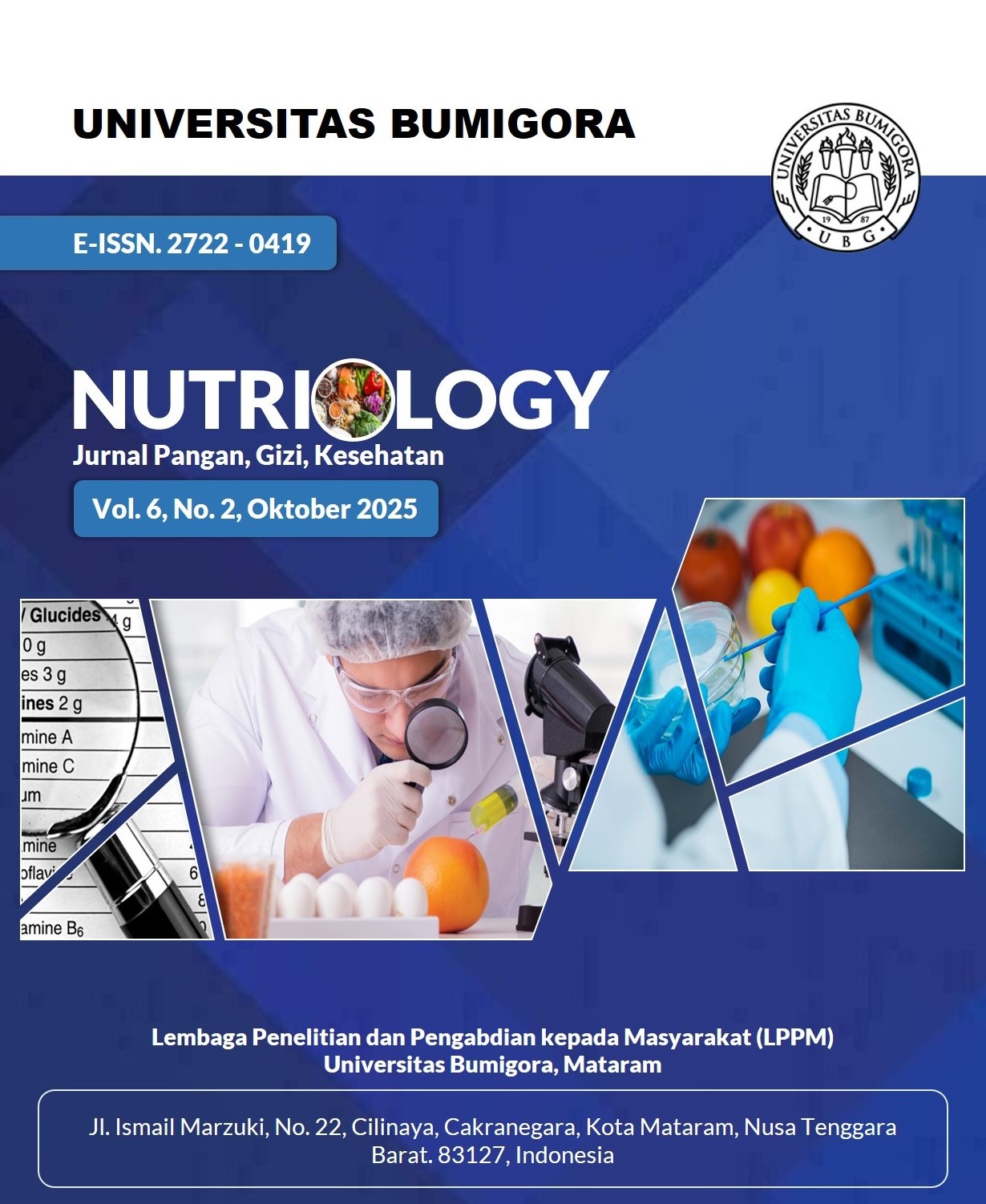Pengaruh Pemberian Formula Daun Sirih Cina dan Jahe Merah terhadap Kadar LDL dan Trigliserida pada Tikus Obesitas
DOI:
https://doi.org/10.30812/nutriology.v6i2.5509Keywords:
daun sirih cina, jahe merah, profil lipid, tikus obesitasAbstract
Obesity is a condition characterized by excessive fat accumulation and is associated with elevated levels of low-density lipoprotein (LDL) cholesterol and triglycerides in the blood. A combination of herbal ingredients such as Chinese betel leaf (Peperomia pellucida L.) and red ginger (Zingiber officinale var. rubrum) is known to contain flavonoids and gingerol, which play a role in reducing blood lipid levels. This study aimed to evaluate the effect of a formulation of Chinese betel leaf and and red ginger on LDL and triglyceride levels in obese male Sprague Dawley rats.. This study was conducted using a true experimental design with a pretest-posttest control group approach. A total of 30 rats were divided into five treatment groups, including a control group and three intervention groups (P1: Chinese betel leaf, P2: red ginger, and P3: a combination of both). The results showed that the combination of 88 mg Chinese betel leaf and 115.5 mg red ginger significantly reduced LDL levels by 57.94% and triglyceride levels by 41.09% (p < 0.05). Conclusion is the combination of Chinese betel leaf and red ginger simplicia was effective in lowering blood lipid levels in an obese rat model.
References
[1] M. Blüher, “An overview of obesity-related complications: The epidemiological evidence linking body weight and other markers of obesity to adverse health outcomes,” Diabetes, Obesity and Metabolism, vol. 27, no. S2, pp. 3–19, 2025, doi: 10.1111/dom.16263.
[2] J. Zhu, Y. Zhang, and Y. et al Wu, “Obesity and dyslipidemia in children,” Nutrients, vol. 14, no. 2321, pp. 1–11, 2022, doi: https://doi.org/10.3390/nu14112321.
[3] World Health Organization, “Obecity and Overweight: Fact Sheet,” Geneva, 2024. [Online]. Available: https://www.who.int/news-room/fact-sheets/detail/obesity-and-overweight
[4] Kementerian Kesehatan RI, “Riskesdas 2018,” 2018.
[5] Kementerian Kesehatan Republik Indonesia, “Survei Kesehatan Indonesia (SKI) Tahun 2023: Hasil Utama,” Jakarta, 2023. [Online]. Available: https://pusdatin.kemkes.go.id/
[6] S. B. Patel et al., “American Association of Clinical Endocrinology Clinical Practice Guideline on Pharmacologic Management of Adults With Dyslipidemia,” Endocrine Practice, vol. 31, no. 2, pp. 236–262, 2025, doi: 10.1016/j.eprac.2024.09.016.
[7] H. Jiang et al., “Mechanisms of Oxidized LDL-Mediated Endothelial Dysfunction and Its Consequences for the Development of Atherosclerosis,” Frontiers in Cardiovascular Medicine, vol. 9, no. June, pp. 1–11, 2022, doi: 10.3389/fcvm.2022.925923.
[8] A. V. Poznyak, V. N. Sukhorukov, R. Surkova, N. A. Orekhov, and A. N. Orekhov, “Glycation of LDL: AGEs, impact on lipoprotein function, and involvement in atherosclerosis,” Frontiers in Cardiovascular Medicine, vol. 10, no. January, pp. 1–7, 2023, doi: 10.3389/fcvm.2023.1094188.
[9] Y. Akivis, H. Alkaissi, S. I. McFarlane, and I. Bukharovich, “The Role of Triglycerides in Atherosclerosis: Recent Pathophysiologic Insights and Therapeutic Implications,” Current Cardiology Reviews, vol. 20, no. 2, pp. 39–49, 2024, doi: 10.2174/011573403x272750240109052319.
[10] C. Khatana et al., “Mechanistic Insights into the Oxidized Low-Density Lipoprotein-Induced Atherosclerosis,” Oxidative Medicine and Cellular Longevity, vol. 2020, no. Table 1, p. 14, 2020, doi: 10.1155/2020/5245308.
[11] D. Krisdayani and C. A. Nugroho, “Uji efektivitas ekstrak etanol tanaman sirih cina (peperomia pellucida l. Kunth) sebagai antihiperglikemia pada mencit (mus musculus l.) Yang diinduksi glukosa,” Biospektrum Jurnal Biologi, vol. 6, no. 1, pp. 1–7, 2025, doi: 10.33508/bios.v6i1.7327.
[12] R. Oktavia, E. J. Anto, and J. M. Siahaan, “Antidiabetic and Anti-inflammatory Effects of Peperomia pellucida Leaf Extract: Modulation of Blood Glucose, IL-1β, and Pancreatic Histopathology in STZ-Induced Diabetic Rats,” Indonesian Journal of Medicine, vol. 10, no. 3, pp. 229–236, 2025, doi: 10.26911/theijmed.2025.10.3.870.
[13] A. K. Salih et al., “Effect of ginger (Zingiber officinale) intake on human serum lipid profile: Systematic review and meta-analysis,” Phytother Res, vol. 37, no. 6, pp. 2472–2483, 2023, doi: 10.1002/ptr.7769.
[14] S. J. Nirvana, T. Widiyani, and A. Budiharjo, “Antihypercholesterolemia activities of red ginger extract (Zingiber officinale Roxb. var rubrum) on wistar rats,” in IOP Conference Series: Materials Science and Engineering, 2020, pp. 1–7. doi: 10.1088/1757-899X/858/1/012025.
[15] D. D. C. H. Rampengan et al., “Red ginger confers antioxidant activity, inhibits lipid and sugar metabolic enzymes, and downregulates miR-21/132 expression,” Journal of Agriculture and Food Research, vol. 18, no. November, p. 101526, 2024, doi: 10.1016/j.jafr.2024.101526.
[16] C. Mazroatul, G. D. Deni, N. A. Habibi, and G. F. Saputri, “Anti-hypercholesterolemia activity of ethanol extract Peperomia pellucida,” ALCHEMY Jurnal Penelitian Kimia, vol. 12, no. 1, p. 88, 2016, doi: 10.20961/alchemy.v12i1.948.
[17] A. Ahmad, “Pengaruh pemberian dangke terhadap kadar glukosa dan lipid darah pada tikus Sprague Dawley,” Universitas Hasanudin Makassar, 2023.
[18] D. A. Veonika, B. Wiboworini, and M. Muthmainah, “Recovery of vitamin D levels by cholecalciferol supplementation on obese rats,” Jurnal Gizi dan Dietetik Indonesia (Indonesian Journal of Nutrition and Dietetics), vol. 1, no. 1, p. 40, 2024, doi: 10.21927/ijnd.2024.1(1).40-48.
[19] Assay Genie, “Triglyceride (TG) Colorimetric Assay Kit (Single Reagent, GPO-PAP) (MAES0165),” Assay Genie. [Online]. Available: https://www.assaygenie.com/triglyceride-assay-kit-colorime tric- maes0165/.
[20] B. Šošić-Jurjević et al., “Effects of age and soybean isoflavones on hepatic cholesterol metabolism and thyroid hormone availability in acyclic female rats,” Experimental Gerontology, vol. 92, no. 4, pp. 74–81, 2017, doi: 10.1016/j.exger.2017.03.016.
[21] S. R. Yurista, R. A. Ferdian, and D. Sargowo, “Prinsip 3Rs dan pedoman arrive pada studi hewan coba,” Jurnal Kardiologi Indonesia, vol. 37, no. 3, pp. 156–163, 2016, doi: 10.30701/ijc.v37i3.579.
[22] H. Sadie-Van Gijsen and L. Kotzé-Hörstmann, “Rat models of diet-induced obesity and metabolic dysregulation: Current trends, shortcomings and considerations for future research,” Obesity Research and Clinical Practice, vol. 17, no. 6, pp. 449–457, 2023, doi: 10.1016/j.orcp.2023.09.010.
[23] A. K. Azevedo-Martins, M. P. Santos, J. Abayomi, N. J. R. Ferreira, and F. S. Evangelista, “The Impact of Excessive Fructose Intake on Adipose Tissue and the Development of Childhood Obesity,” Nutrients , vol. 16, no. 7, pp. 1–19, 2024, doi: 10.3390/nu16070939.
[24] S. Kovačević et al., “Fructose Induces Visceral Adipose Tissue Inflammation and Insulin Resistance Even Without Development of Obesity in Adult Female but Not in Male Rats,” Frontiers in Nutrition, vol. 8, no. November, pp. 1–18, 2021, doi: 10.3389/fnut.2021.749328.
[25] B. P. Melo et al., “Thirty days of combined consumption of a high-fat diet and fructose-rich beverages promotes insulin resistance and modulates inflammatory response and histomorphometry parameters of liver, pancreas, and adipose tissue in Wistar rats,” Nutrition, vol. 91–92, no. November-DEsember, pp. 1–10, 2021, doi: https://doi.org/10.1016/j.nut.2021.111403.
[26] Z. Li et al., “Fructose metabolism and its roles in metabolic diseases, inflammatory diseases, and cancer,” Molecular Biomedicine, vol. 6, no. 1, p. 29, 2025, doi: 10.1186/s43556-025-00287-2.
[27] B. Burhanudin, “The metabolic and molecular mechanisms linking fructose consumption to lipogenesis and metabolic disorders,” Clinical Nutrition ESPEN, vol. 69, no. Oktober, pp. 63–68, 2025, doi: 10.1016/j.clnesp.2025.06.042.
[28] Teodhora, R. Hendriani, S. A. Sumiwi, and J. Levita, “Peperomia Pellucida (L.) Kunth: A Decade of Ethnopharmacological, Phytochemical, and Pharmacological Insights (2014–2025),” Journal of Experimental Pharmacology, vol. 17, no. July, pp. 417–454, 2025, doi: 10.2147/JEP.S532898.
[29] H. An, Y. Jang, J. Choi, J. Hur, S. Kim, and Y. Kwon, “New Insights into AMPK, as a Potential Therapeutic Target in Metabolic Dysfunction-Associated Steatotic Liver Disease and Hepatic Fibrosis,” Biomolecules and Therapeutics, vol. 33, no. 1, pp. 18–38, 2025, doi: 10.4062/biomolther.2024.188.
[30] J. Broeckel et al., “Effects of Ginger Supplementation on Markers of Inflammation and Functional Capacity in Individuals with Mild to Moderate Joint Pain †,” Nutrients, vol. 17, no. 14, pp. 1–22, 2025, doi: 10.3390/nu17142365.
[31] Y. Alhamoud, J. Wu, M. I. Ahmad, F. Chen, F. Feng, and J. Wang, “6-Gingerol induces browning of white adipose tissue to improve obesity through PI3K/AKT-RPS6-mediated thermogenesis pathway,” Food Frontiers, vol. 4, no. 3, pp. 1285–1297, 2023, doi: 10.1002/fft2.251.
[32] F. F. Lillich, J. D. Imig, and E. Proschak, “Multi-Target Approaches in Metabolic Syndrome,” Frontiers in Pharmacology, vol. 11, no. March, pp. 1–18, 2021, doi: 10.3389/fphar.2020.554961.
[33] H. Li, A. R. Rafie, A. Hamama, and R. A. Siddiqui, “Immature ginger reduces triglyceride accumulation by downregulating Acyl CoA carboxylase and phosphoenolpyruvate carboxykinase-1 genes in 3T3-L1 adipocytes,” Food and Nutrition Research, vol. 67, no. January 2023, pp. 1–18, 2023, doi: 10.29219/fnr.v67.9126.
[34] Q. Xia et al., “6-Gingerol regulates triglyceride and cholesterol biosynthesis to improve hepatic steatosis in MAFLD by activating the AMPK-SREBPs signaling pathway,” Biomedicine & Pharmacotherapy, vol. 170, no. Januari, pp. 1–19, 2024, doi: 10.1016/j.biopha.2023.116060.
[35] S. Kim et al., “Ginger extract ameliorates obesity and inflammation via regulating MicroRNA-21/132 expression and AMPK activation in white adipose tissue,” Nutrients, vol. 10, no. 11, pp. 1–12, 2018, doi: 10.3390/nu10111567.
[36] M. Li et al., “Natural products targeting AMPK signaling pathway therapy, diabetes mellitus and its complications,” Frontiers in Pharmacology, vol. 16, no. February, pp. 01–30, 2025, doi: 10.3389/fphar.2025.1534634.
[37] R. R. Al-Yousef, M. M. Abbas, R. Obeidat, and M. A. Abbas, “Rhamnetin decreases the expression of HMG-CoA reductase gene and increases LDL receptor in HepG2 cells,” Journal of Pharmacy and Pharmacognosy Research, vol. 11, no. 1, pp. 47–54, 2023, doi: 10.56499/jppres22.1507_11.1.47.
Downloads
Published
Issue
Section
License
Copyright (c) 2025 Sufiati Bintanah, Retno Arra Saraswati, Imtiyaz Halimah Al Sa’diyah, Rr. Annisa Ayuningtyas

This work is licensed under a Creative Commons Attribution 4.0 International License.










